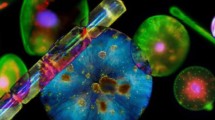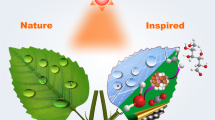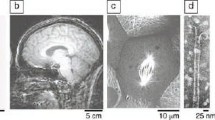Abstract
I’ve long been suspicious about attempts to see energy as the overwhelmingly central item setting both options and criteria for design in nature. Indeed, when I tried to create a conceptual framework for teaching biology to college students, I ended up putting energy distinctly second to information. Where energy rules, one can find some analog of voltage potential. But in nature, who eats whom boils down to the design and operation of one’s particular teeth and other equipment. I once set up an electrical analog of an ecosystem, but it gave an unreasonable picture until I added ad hoc diodes to keep the trees from eating the caterpillars at night and other such misbehavior. (Steve Vogel, Duke University, 2007)
In materials processing, Nature replaces the massive use of energy (for example high temperatures or harsh chemical reactions) with the use of information (which equates with structure at all levels, molecule to ecosystem). Indeed, most of the exceptional functionality of biological materials is due to their complex structure, driven by their chemical composition and morphology derived from DNA. It is here that the most important aspect of biomimetics emerges, and it has the power to redesign engineering.







Similar content being viewed by others
References
E. Arzt, S. Gorb, R. Spolenak: From micro to nano contacts in biological attachment devices. Proc. Nat. Acad. Sci. U.S.A. 100, 10603 2003
W. Barthlott, C. Neinhuis: Purity of the sacred lotus, or escape from contamination in biological surfaces. Planta 202, 1 1997
S.A. Velcro: Improvements in or relating to a method and a device for producing a velvet type fabric. Swiss Patent No. 721338 (1955)
L.H. Shu, I. Chiu: Natural language analysis for biomimetic design, presented at ASME Design Engineering Technical Conference, DETC2004 (2004)
D.W. Urry: Elastic biomolecular machines. Sci. Am. 272, 44 1995
G. Altshuller: The Innovation Algorithm, TRIZ, Systematic Innovation and Technical Creativity Technical Innovation Center Inc Worcester, MA 1999
J.F.V. Vincent, O. Bogatyreva, A-K. Pahl, N. Bogatyrev, A. Bowyer: Putting biology into TRIZ: A database of biological effects. Creativ. Innovat. Manage. 14, 66 2005
J.F.V. Vincent: Deconstructing the design of a biological material. J. Theor. Biol. 236, 73 2005
J.F.V. Vincent, O.A. Bogatyreva, N.R. Bogatyrev, A. Bowyer, A-K. Pahl: Biomimetics—Its practice and theory. J. R. Soc. Interface 3, 471 2006
J.E. Hillerton, J.F.V. Vincent: The specific location of zinc in insect mandibles. J. Exp. Biol. 101, 333 1982
H.C. Lichtenegger, T. Schöberl, J.T. Ruokolainen, J.O. Cross, S.M. Heald, H. Birkedal, J.H. Waite, G.D. Stucky: Zinc and mechanical prowess in the jaws of Nereis, a marine worm. Proc. Nat. Acad. Sci. U.S.A. 100, 9144 2003
E.I. Jones, R.A. McCance, L.R.B. Shackleton: The role of iron and silica in the structure of radular teeth of certain marine molluscs. J. Exp. Biol. 12, 65 1935
P.J. Motta: A quantitative analysis of ferric iron in butterfly fish teeth (Chaetodontidae, Perciformes) and the relationship to feeding ecology. Can. J. Zool. 65, 106 1987
J.M. Gosline, P.A. Guerette, C.S. Ortlepp, K.N. Savage: The mechanical design of spider silks: From fibroin sequence to mechanical function. J. Exp. Biol. 202, 3295 1999
U.G.K. Wegst: The mechanical performance of natural materials. Ph.D. Thesis, Cambridge University, Cambridge, UK (1996)
K.O. Stetter: Extremophiles and their adaptation to hot environments. FEBS Lett. 452, 22 1999
F-X. Sicot, M. Mesnage, M. Masselot, J-Y. Exposito, R. Garrone, J. Deutsch, F. Gaill: Molecular adaptation to an extreme environment: origin of the thermal stability of the pompeii worm collagen. J. Mol. Biol. 302, 811 2000
E.C. Bell, J.M. Gosline: Mechanical design of mussel byssus: Material yield enhances attachment strength. J. Exp. Biol. 199, 1005 1996
A.P. Jackson, J.F.V. Vincent, R.M. Turner: The mechanical design of nacre. Proc. R. Soc. London, B Ser. 234, 415 1988
G. Mayer: New classes of tough composite materials—Lessons from natural rigid biological systems. Mater. Sci. Eng., C 26, 1261 2006
J.D. Currey: The design of mineralised hard tissues for their mechanical functions. J. Exp. Biol. 202, 3285 1999
O. Bogatyreva, A. Shillerov, N. Bogatyrev: Patterns in TRIZ contradiction matrix: Integrated and distributed systems in 4th ETRIA Symposium, edited by G. Cascini Firenze University Press Florence, Italy 2004 305
J.F.V. Vincent, O. Bogatyreva, N. Bogatyrev, A.-K. Pahl, A. Bowyer: A theoretical basis for biomimetics in Mechanical Behavior of Biological and Biomimetic Systems, edited by A.J. Bushby, V.L. Ferguson, C-C. Ko, and M.L. Oyen (Mater. Res. Soc. Symp. Proc. 898E, Warrendale, PA, 2005), L14
J.F.V. Vincent, U.G.K. Wegst: Design and mechanical properties of insect cuticle. Arthropod Struct. Dev. 33, 187 2004
M.F. Ashby, Y.J.M. Brechet: Designing hybrid materials. Acta Mater. 51, 5801 2003
A.C. Neville: Biology of Fibrous Composites: Development beyond the Cell Membrane The University Press Cambridge 1993
P.B. Green, C.S. Steele, S.C. Rennich: Phyllotactic patterns: A biophysical mechanism for their origin. Ann. Bot. (London) 77, 515 1996
R.S. Lakes: Materials with structural hierarchy. Nature 361, 511 1993
S.V. Lomov, G. Huysmans: Hierarchy of textile structures and architecture of fabric geometric models. Text. Res. J. 71, 534 2001
G.E. Padawer, N. Beecher: On the strength and stiffness of planar reinforced plastic resins. Polym. Eng. Sci. 10, 185 1970
G. Jeronimidis: Wood, one of nature’s challenging composites in The Mechanical Properties of Biological Materials, edited by J.F.V. Vincent and J.D. Currey (The University Press, Cambridge, UK, 1980) p. 169
J.L. Katz: The structure and biomechanics of bone in The Mechanical Properties of Biological Materials, edited by J.F.V. Vincent and J.D. Currey (The University Press, Cambridge, UK, 1980) p. 137
K.S. Tai, M. Dao, S. Suresh, A. Palazoglu, C. Ortiz: Nanoscale heterogeneity promotes energy dissipation in bone. Nat. Mater. 6, 454 2007
D.G. Hepworth, J.F.V. Vincent, G. Stringer, G. Jeronimidis: Variations in the morphology of wood structure can explain why hardwood species of similar density have very different resistances to impact and compressive loading. Philos. Trans. R. Soc. London, Ser. A 360, 255 2002
U. Kull, A. Herbig, F. Otto: Construction and economy of plant stems as revealed by use of the bic-method. Ann. Bot. (London) 69, 327 1992
N.M. Pugnoy, R.S. Ruoff: Quantized fracture mechanics. Philos. Mag. 84, 2829 2004
H. Gao, B. Ji, I.L. Jaeger, E. Arzt, P. Fratzl: Materials become insensitive to flaws at nanoscale: Lessons from nature. Proc. Natl. Acad. Sci. USA 100, 5597 2003
P. Zioupos, J.D. Currey, A.J. Sedman: An examination of the micromechanics of failure of bone and antler by acoustic emission tests and laser scanning confocal microscopy. Med. Eng. Phys. 16, 203 1994
Acknowledgments
I am grateful to Olga and Nikolay Bogatyrev for my education in TRIZ and the data in Fig. 3.
Author information
Authors and Affiliations
Corresponding author
Rights and permissions
About this article
Cite this article
Vincent, J.F. Biomimetic materials. Journal of Materials Research 23, 3140–3147 (2008). https://doi.org/10.1557/JMR.2008.0380
Received:
Accepted:
Published:
Issue Date:
DOI: https://doi.org/10.1557/JMR.2008.0380




